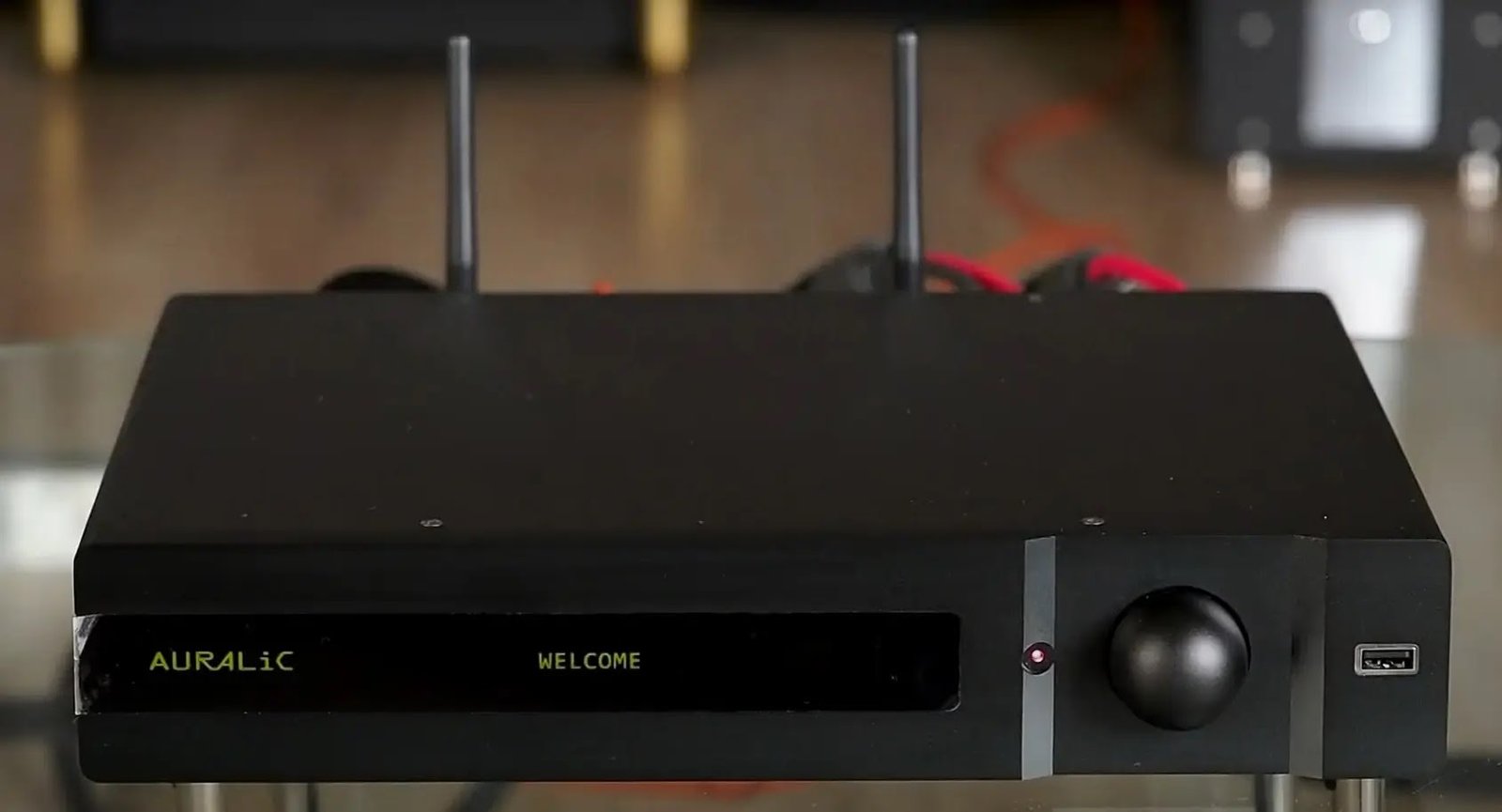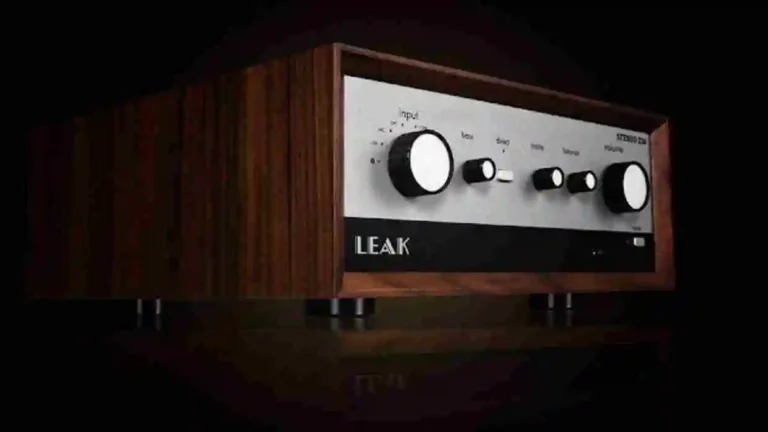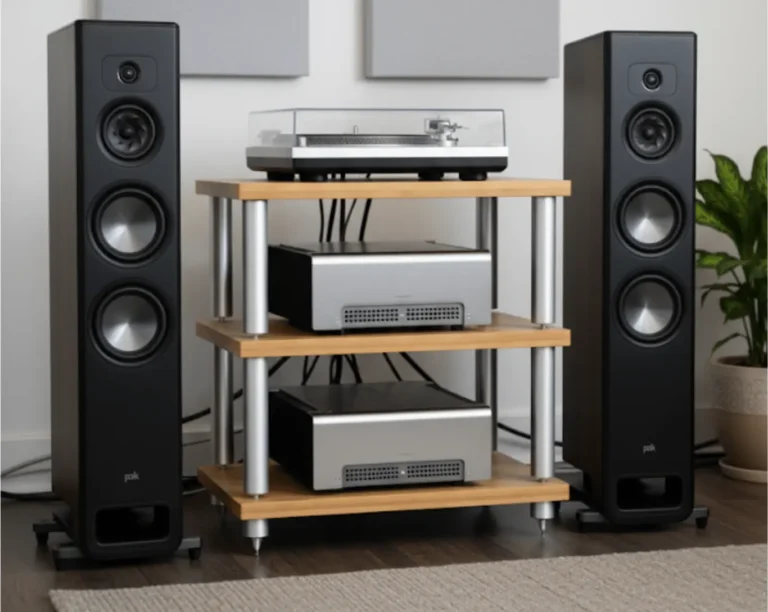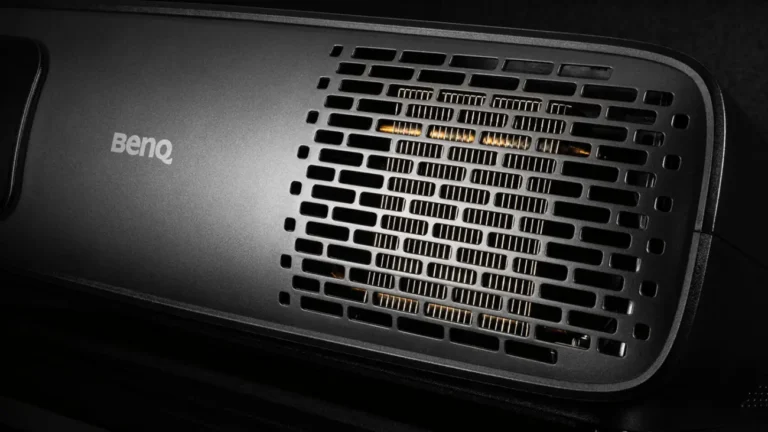Auralic Polaris Review: The All-in-One That Does It All
Auralic Polaris: As a well-equipped streamer, it rightly asks the question: Is such a device more hi-fi fast food or already an audiophile designer drug? The answer, it turns out, is surprisingly clear.
Whenever the author of these lines tests a good all-in-one device, he briefly longs for a solid, steady hi-fi life without the constant assembly, disassembly, comparison, re-plugging, unpacking, and repacking. A life without cardboard storage cluttering the hallway and every reachable niche of the apartment. And without the stacks of devices and the tangle of cables that an active test cycle sometimes entails.
A radical counter-utopia to this nerdy technological overload is the streaming amplifier. These devices, available for several years now, can make an entire system including the player, almost disappear without significant sonic compromise. T+A, Linn, and Naim were pioneers of this movement. Auralic took its time, presenting its all-rounder, the Auralic Polaris, just this year. It’s a powerful integrated amplifier with digital and analog inputs (one of which can be switched to Phono MM) and a sophisticated streamer that supports Tidal, Qobuz, any hard disk or DLNA server, Internet radio, Bluetooth, Airplay, Multiroom, and even the Roon playback protocol.
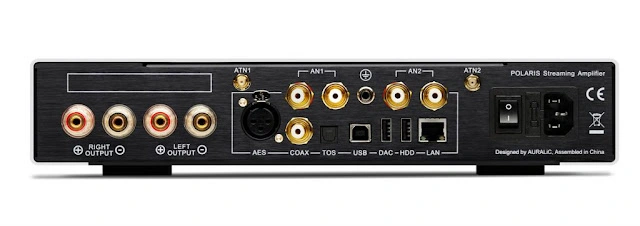
Core Technology and Build
The Chinese company Auralic generally does not tend to be slow to adopt trends or follow well-trodden technological paths. On the contrary, its developers have repeatedly caused a stir with their explosive development speed. With their Lightning platform, they have one of the most powerful and effective streaming engines on the market. Time and again, whether with DSD streaming, service integration, or server functions, established competitors have watched as Auralic co-founder Xuanqian Wang and his team announced feature implementation while others were still in the starting blocks.
The streaming heart of the Auralic Polaris is reassuringly oversized, with an ARM Cortex A9 quad-core processor and plenty of RAM. This platform first appeared in the purely digital Aries streaming bridge, a modern successor to the audiophile CD transport, tailor-made for the USB DACs highly valued by computer audiophiles. The cute Aries Mini then inherited these capabilities, but with an integrated D/A converter, it became a complete player, even offering a slot for a 2.5″ hard drive or SSD in its compact housing.
The Auralic Polaris streaming integrated amplifier tested here also has this option. For the neatest possible setup, you can integrate the server physically and logically into the Polaris, leaving only one device in your living room. Not even a network cable is required, as the device connects to the home WLAN via the modern 802.11ac standard, guaranteeing dropout-free music enjoyment even with ultra-high-resolution files. Only the power and speaker cables need to be connected conventionally.
You can see that the Auralic Polaris is not a budget device. With its precisely fitted housing, cleanly centered and wobble-free rotary encoder, and amber-colored, high-resolution dot-matrix display, it exudes a reserved class impression that, unfortunately, does not extend to the cheap, DVD-player-style remote control.
App and Server Control
In streaming mode, however, the infrared remote is rarely used. Control is primarily handled by Auralic’s own “Lightning DS” app, for example, on an iPad. It guides the owner through the setup process and, while requiring a little patience at times, remains detailed, clear, and logical.
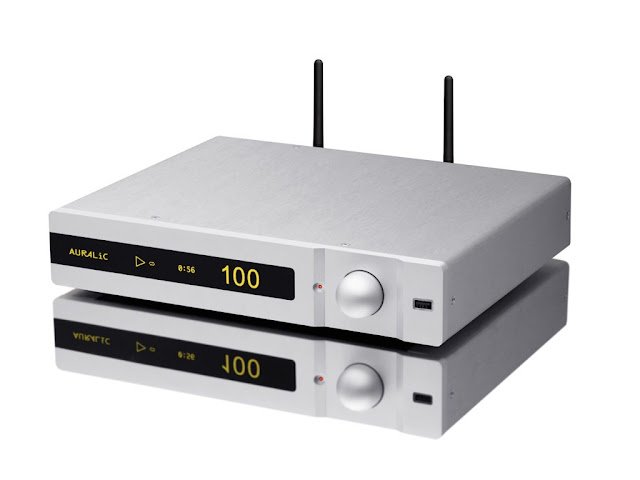
Once the streamer is ready and the latest firmware is installed (done automatically over the network), the app asks which music library to use. If accessing an existing DLNA server (e.g., on a NAS), the app simply imports its data and cover art. The app cleverly buffers all lists locally, so subsequent searches and scrolling through albums are incredibly fast and smooth, even with collections containing thousands of albums.
Operation is even more convenient using its own server intelligence. The integrated Lightning Server is a full-fledged DLNA server that offers more practical sorting criteria—such as file format, modification date, or bit rate than typical NAS software. Once running, it’s also available to any other streamer on the same network. This allows you to switch from the main system in the living room to a streaming box in the kitchen without having to learn a new server layout.
Since the Lightning Server must first index the metadata of all music files, initial setup takes some time. The test device cataloged the roughly 30,000 titles on the author’s NAS in just under an hour, where the limiting factor was likely the ten-year-old network storage, not the Polaris itself. In addition to network drives, the Lightning Server can index USB storage connected to the Auralic Polaris or the aforementioned internal 2.5″ disk. According to a planned update, it will also be possible to combine multiple storage locations into one comprehensive library. At the time of testing, you had to choose between internal, USB, or network storage, but switching is quick as the server remembers the different databases.
High-Res Formats and MQA
Regardless of the storage medium, the Auralic Polaris plays every hi-fi-relevant file format, including exotic ultra-high-resolution files up to DSD512 (approximately 22.5 MHz) and PCM formats up to 32-bit/384 kHz. “Fun” is relative here, as there is very little music available in these extreme formats. In contrast, “normal” Hi-Res, around 24-bit/96 kHz, is widely available from providers like Highresaudio.com, covering not just jazz and classical but also many rock and alternative albums. The fact that High-Res downloads often sound better than their CD equivalents is not always due to the higher sampling rate but often because they are mastered with more dynamics and less compression for their audiophile target audience.
You May Like: Aris THE 30 tube integrated amplifier Review
This fact is also an argument against MQA’s “one file for all resolutions” approach. If the mass market and the high-end niche are served with the same product, that file will logically be optimized for the mass market. While the possibility of target-group-specific mastering remains, it’s likely to be used less frequently. As a reminder, ordinary streamers treat MQA files like standard FLACs. The high-res subtleties are only revealed with a proprietary decoder.
Auralic takes an interesting middle ground: Xuanqian Wang did not license the format but programmed his own decoding algorithms. In listening tests, these delivered results very similar to “official” MQA equipment. For example, with the Vivaldi cantatas on the album Bellezza Crudel, the MQA stream from Tidal, unpacked by the Polaris, sounded more focused, finer, and richer in substance than the standard 44.1/16 FLAC from the NAS.
In addition to NAS disks in the home network, the Lightning server can also search and sort USB storage devices connected directly to the Auralic Polaris or the internally pluggable 2.5″ disk mentioned above, and offer them clearly for selection via the app. According to an update that has already been announced, it should also be possible to combine several storage locations into one comprehensive collection.
The primary appeal of MQA is that the streaming service Tidal offers thousands of MQA-coded albums as part of the normal “Tidal HiFi” subscription at no extra charge.
Analog Inputs and Amplification
In the test, the playlist included not only Tidal but also digital material from the local NAS and analog LPs from a Linn LP12, connected both via the Polaris’s internal phono input and external phono stages. However, the signal path is not purely analog. All signals pass through Auralic’s hybrid volume control, which combines analog-switched 12dB level stages with fine digital adjustment. This offers the advantage that digital signals retain their full resolution even at low volumes. Analog signals, on the other hand, are first passed through an A/D converter to travel the same digital path.
Vinyl purists will therefore probably not make the Auralic Polaris their first choice, given its opulent digital feature set; it would be overqualified for such a user anyway. That said, its MM phono input sounds very good, and the detour through the digital domain is not noticeable in normal listening. The special beauty of good records is fully preserved. This experience is made more surprising by the fact that the Polaris uses a Class D power amplifier from Hypex and a switched-mode power supply. This design has a huge advantage: immense power from a compact and lightweight (4.5 kg) chassis. Auralic specifies power at 120 watts per channel into 8 ohms and 180 watts into 4 ohms. After long and loud listening sessions, I can confirm this is entirely believable.
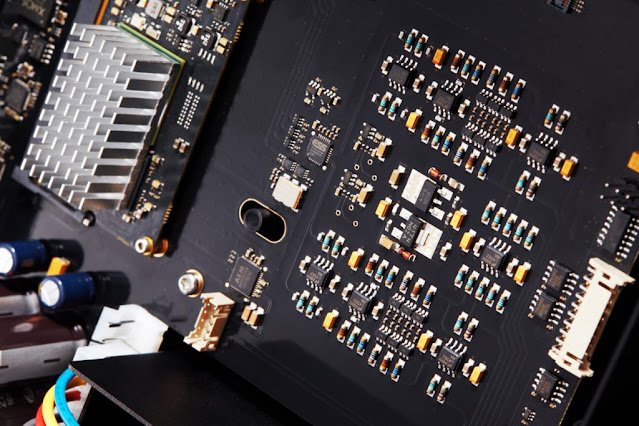
Sound Quality
It’s interesting, but this device can sound warmer and more natural than some all-analog systems. The Polaris plays music with immense power and a smooth, rich quality. It’s more focused on making music enjoyable than picking it apart with extreme detail. It remains relaxed and never becomes harsh or sharp, even when played very loud on large speakers. Compared to other all-in-one players, the Auralic Polaris feels the most powerful and smooth.
This powerful, relaxed tuning is complemented by the choice of DAC: the natural, clean-sounding ESS SABRE9016 chip. Its character can be subtly shaped by four selectable digital filter algorithms. During testing, the “Precise” setting paired best with older Naim speakers for a touch of freshness, while the “Smooth” or “Balanced” options suited new Klipsch Forte IIIs. This is not tone control; these filters are part of the DAC process, affecting impulse behaviour and the removal of high-frequency artifacts, not the audible frequency response.
These settings, along with balance, absolute phase, and input assignment, are accessed via the front display using either the remote or the multifunction knob. The system is extremely well-thought-out and practical. There is one minor annoyance, though Auralic has stated it is being fixed: at the time of testing, the Lightning DS app could only control the Polaris if the streamer input was already selected. Switching from an analog or digital source required using the remote first. Unconditional app control in all modes would make the integration feel perfect.
From a hi-fi perspective, a turntable remains a sensible addition for music only available on vinyl. However, for anything released digitally, the internal streamer is the best source. External digital transports offer no advantage over the internal player, which is clocked by Auralic’s high-precision femto clock. External complete players or DACs are rendered redundant, as their output would simply be re-digitized and re-converted by Polaris’s own superior internal systems.
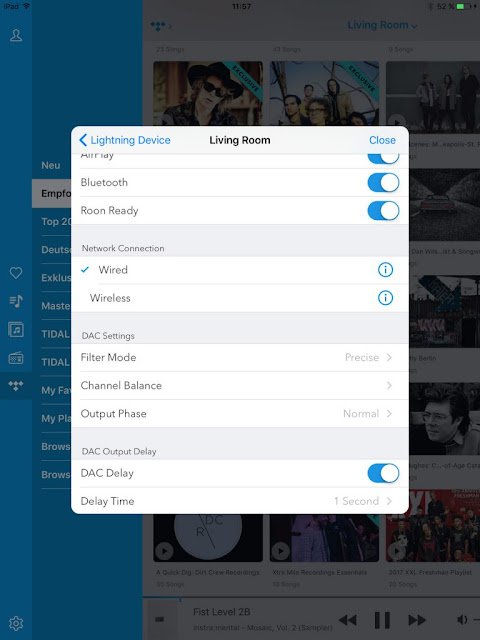
Conclusion Auralic Polaris
One could argue that the Auralic Polaris blocks the path to future source upgrades, but this is an academic limitation. Its greatest achievement is creating a home environment where you no longer need to think about upgrades and hi-fi complexity. It is a highly attractive device for demanding beginners, but it is ultimately a “drop-out” device ideal for those who, after years of ambitious hi-fi and its attendant complexity, yearn for a simpler solution that involves no compromises. Once you find the right speakers, the only meaningful task left is to search for new, exciting music. The Polaris provides a solid foundation for everything else.
Pros And Cons
Pros:
- Powerful, Musical Sound
- Excellent Software and User Experience
- Comprehensive Format and Service Support
- Connectivity
- High-Quality Build and Design
- Powerful Amplification
Cons:
- Price Point
- Learning Curve
- Limited Phono Input
- No HDMI Inputs
Auralic Polaris Specifications
More Detail: Here
Amplifier Section
- Power Output: 120 Watts per channel into 8Ω, 180 Watts per channel into 4Ω
- Amplifier Type: Class-D (Utilizing Hypex UCD modules)
- Frequency Response: 20Hz−20kHz,±0.5dB
- THD+N: <0.01%,20Hz−20kHz at 1W
Streaming & Digital Section
- Processor: Quad-Core ARM Cortex-A9, 1GHz
- Memory: 1GB DDR3 RAM, 4GB System Storage
- DAC Chip: ESS Sabre 9016
- Streaming Platform: Auralic Lightning Streaming
- Supported File Formats: AAC, AIFF, ALAC, APE, DFF, DSF, FLAC, MP3, OGG, WAV, WV, WMA
- Supported Sampling Rates:
- PCM: 44.1kHz to 384kHz in 32-bit
- DSD: DSD64, DSD128, DSD256, DSD512
- Streaming Services: TIDAL, Qobuz, Internet Radio
- Protocols: Roon Ready, UPnP/DLNA, AirPlay, Bluetooth
Inputs
- Digital: 1x AES/EBU, 1x Coaxial, 1x Toslink, 1x USB (for computer audio)
- Analog: 1x RCA Line-level, 1x RCA Phono (MM, software configurable)
- Storage: 1x USB (for external drives), 1x Internal Bay for 2.5″ HDD/SSD
Outputs
- Speaker: 1x Pair of stereo binding posts
- Analog: 1x RCA Pre-Out (for external power amp), 1x 6.35mm Headphone Jack
Network Connectivity
- Wired: Gigabit Ethernet
- Wireless: 802.11b/g/n/ac Tri-Band Wi-Fi
General
- Control Software: Auralic Lightning DS for iOS; any OpenHome or UPnP compatible software
- Display: 3-inch OLED display
- Dimensions (W x D x H): 33cm×26cm×6.5cm
- Weight: 4.5 kg (9.9 lbs)

